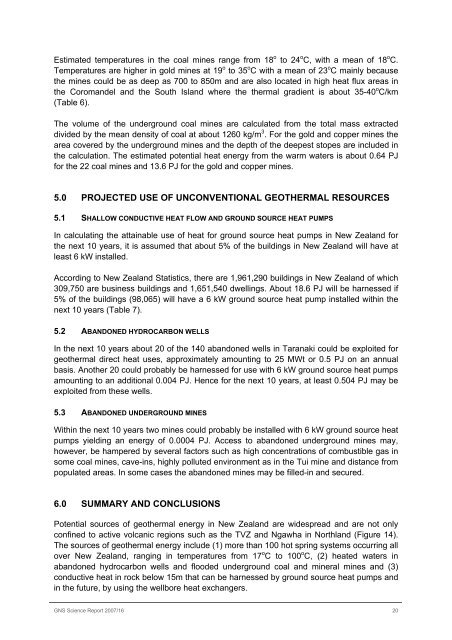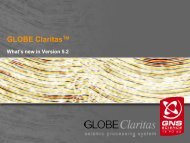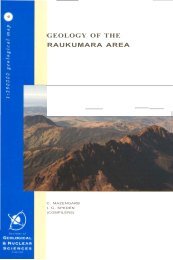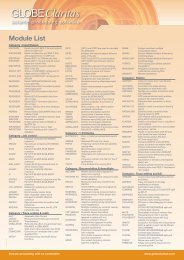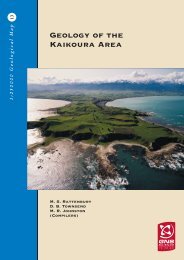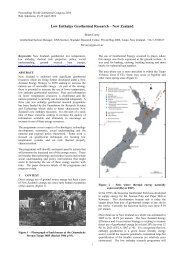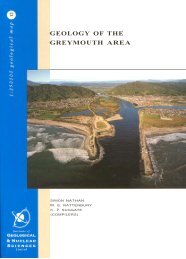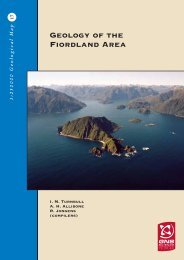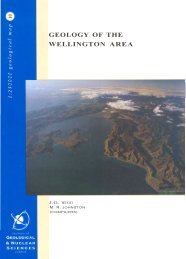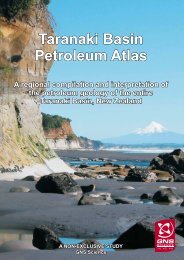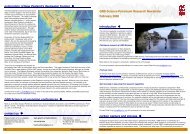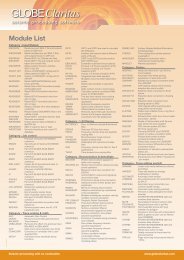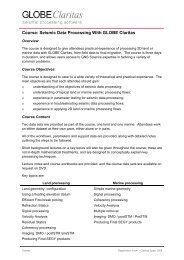sources of energy for geothermal direct heat use - GNS Science
sources of energy for geothermal direct heat use - GNS Science
sources of energy for geothermal direct heat use - GNS Science
- No tags were found...
You also want an ePaper? Increase the reach of your titles
YUMPU automatically turns print PDFs into web optimized ePapers that Google loves.
Estimated temperatures in the coal mines range from 18 o to 24 o C, with a mean <strong>of</strong> 18 o C.Temperatures are higher in gold mines at 19 o to 35 o C with a mean <strong>of</strong> 23 o C mainly beca<strong>use</strong>the mines could be as deep as 700 to 850m and are also located in high <strong>heat</strong> flux areas inthe Coromandel and the South Island where the thermal gradient is about 35-40 o C/km(Table 6).The volume <strong>of</strong> the underground coal mines are calculated from the total mass extracteddivided by the mean density <strong>of</strong> coal at about 1260 kg/m 3 . For the gold and copper mines thearea covered by the underground mines and the depth <strong>of</strong> the deepest stopes are included inthe calculation. The estimated potential <strong>heat</strong> <strong>energy</strong> from the warm waters is about 0.64 PJ<strong>for</strong> the 22 coal mines and 13.6 PJ <strong>for</strong> the gold and copper mines.5.0 PROJECTED USE OF UNCONVENTIONAL GEOTHERMAL RESOURCES5.1 SHALLOW CONDUCTIVE HEAT FLOW AND GROUND SOURCE HEAT PUMPSIn calculating the attainable <strong>use</strong> <strong>of</strong> <strong>heat</strong> <strong>for</strong> ground source <strong>heat</strong> pumps in New Zealand <strong>for</strong>the next 10 years, it is assumed that about 5% <strong>of</strong> the buildings in New Zealand will have atleast 6 kW installed.According to New Zealand Statistics, there are 1,961,290 buildings in New Zealand <strong>of</strong> which309,750 are business buildings and 1,651,540 dwellings. About 18.6 PJ will be harnessed if5% <strong>of</strong> the buildings (98,065) will have a 6 kW ground source <strong>heat</strong> pump installed within thenext 10 years (Table 7).5.2 ABANDONED HYDROCARBON WELLSIn the next 10 years about 20 <strong>of</strong> the 140 abandoned wells in Taranaki could be exploited <strong>for</strong><strong>geothermal</strong> <strong>direct</strong> <strong>heat</strong> <strong>use</strong>s, approximately amounting to 25 MWt or 0.5 PJ on an annualbasis. Another 20 could probably be harnessed <strong>for</strong> <strong>use</strong> with 6 kW ground source <strong>heat</strong> pumpsamounting to an additional 0.004 PJ. Hence <strong>for</strong> the next 10 years, at least 0.504 PJ may beexploited from these wells.5.3 ABANDONED UNDERGROUND MINESWithin the next 10 years two mines could probably be installed with 6 kW ground source <strong>heat</strong>pumps yielding an <strong>energy</strong> <strong>of</strong> 0.0004 PJ. Access to abandoned underground mines may,however, be hampered by several factors such as high concentrations <strong>of</strong> combustible gas insome coal mines, cave-ins, highly polluted environment as in the Tui mine and distance frompopulated areas. In some cases the abandoned mines may be filled-in and secured.6.0 SUMMARY AND CONCLUSIONSPotential <strong>sources</strong> <strong>of</strong> <strong>geothermal</strong> <strong>energy</strong> in New Zealand are widespread and are not onlyconfined to active volcanic regions such as the TVZ and Ngawha in Northland (Figure 14).The <strong>sources</strong> <strong>of</strong> <strong>geothermal</strong> <strong>energy</strong> include (1) more than 100 hot spring systems occurring allover New Zealand, ranging in temperatures from 17 o C to 100 o C, (2) <strong>heat</strong>ed waters inabandoned hydrocarbon wells and flooded underground coal and mineral mines and (3)conductive <strong>heat</strong> in rock below 15m that can be harnessed by ground source <strong>heat</strong> pumps andin the future, by using the wellbore <strong>heat</strong> exchangers.<strong>GNS</strong> <strong>Science</strong> Report 2007/16 20


